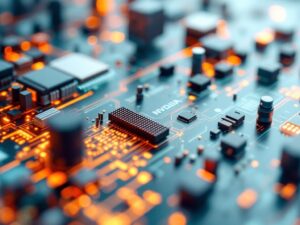
BREAKING: Nvidia Corp. has declared a significant lead over Google in the artificial intelligence chip race, asserting that its latest graphics processing units (GPUs) are a full “generation ahead” of Google’s custom silicon efforts. This bold claim comes amid escalating tensions between the two tech giants as they compete in the rapidly evolving AI landscape.
In a revealing statement reported by CNBC, Nvidia’s executives have positioned their H100 GPUs and forthcoming Blackwell architecture as superior to Google’s internal Tensor Processing Units (TPUs). This assertion marks a shift in the narrative as tech companies invest billions to reduce dependence on Nvidia’s technology, highlighting the high stakes involved in the AI infrastructure market.
Nvidia’s confidence arises not only from raw performance metrics but also from advantages in memory bandwidth and networking capabilities that Google’s TPUs reportedly struggle to match. Analysts note that as models expand into trillions of parameters, communication speed between chips becomes the critical factor, a domain where Nvidia claims dominance.
UPDATE: The confrontation underscores a growing divide in capital expenditure strategies. Google’s push for custom silicon aims to control costs, yielding significant savings compared to purchasing Nvidia chips. However, Nvidia counters that its technology offers a crucial edge in “time-to-intelligence,” stating that faster training times can outweigh the initial hardware investment.
According to a Bloomberg report, Google saves on margin with its internal chip production, but Nvidia emphasizes that the opportunity cost of delayed market entry is too high in the fast-paced AI sector. The firm argues that even if Google can design competitive chips, it cannot innovate faster than a company solely focused on R&D for AI hardware.
The software landscape further complicates the competition. Nvidia’s CUDA platform remains the gold standard for AI developers, while Google promotes alternatives like JAX and XLA. However, most AI research continues to occur on Nvidia hardware, creating a significant barrier for companies attempting to transition to TPUs.
Nvidia’s claims also raise concerns about fragmentation within the AI ecosystem. If each tech giant develops its own proprietary solutions, interoperability of AI models could suffer. Nvidia positions itself as the “Switzerland” of AI hardware, advocating for standardization that facilitates scalable solutions across platforms.
As the market reacts, Wall Street analysts are closely monitoring Nvidia’s aggressive stance. They warn that if Google’s TPUs are perceived as viable alternatives, Nvidia risks losing pricing power. Yet, if Nvidia’s claim of being “a generation ahead” holds true, it can maintain premium pricing and solidify its market position.
The conflict also extends to cloud services, where third-party providers struggle to access sufficient Nvidia compute power, making Google’s TPU-equipped cloud offerings appealing. However, Nvidia’s rhetoric suggests a quality compromise, pushing enterprise customers to demand Nvidia solutions, thereby funding their competitor.
Despite the heated rivalry, industry experts predict a heterogeneous future for data centers. Nvidia’s high-performance GPUs may dominate demanding tasks, while Google’s TPUs could handle routine operations efficiently. This dual approach indicates an evolving landscape where both companies will play vital roles.
As the AI arms race intensifies, Nvidia’s claim serves as a reminder that in the semiconductor industry, incumbency is not a guarantee of continued dominance. With Google’s vast resources, the competition for the next generation of AI technology is far from over. For now, Nvidia maintains its lead, signaling to the market that to build the future of AI, companies must still pay the price for their cutting-edge technology.





